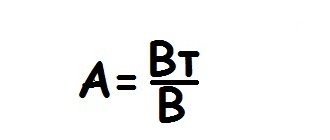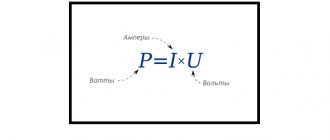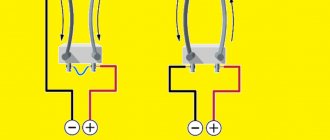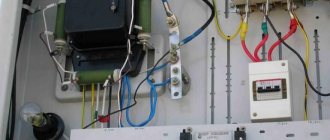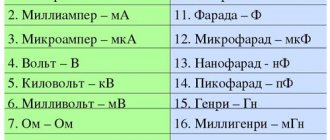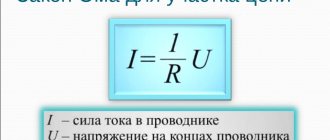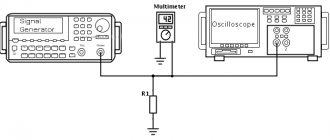Author of the article
Alexander Georgievich Kondratiev
An electrical engineer by training, he worked as an electronics engineer, chief engineer at a food company, and general director of a construction organization.
Knowing the installed power of electrical appliances is important for the correct selection of electrical wiring and protection devices. This is necessary to ensure the safe operation of appliances in the home.
The power of household electrical appliances is measured in watts, and in calculations of high-power electrical networks the concept of kilowatt is used. Therefore, the owner, before making calculations, needs to know what equipment is installed in the house and what power it is. And for design you need to figure out how many watts are in a kilowatt.
How to calculate electrical energy consumption
In an era when it is difficult to imagine your life without electrical appliances, and the price of energy is constantly rising, it is important to be able to plan and calculate. Calculating electricity consumption is important both for planning future costs for paying electricity bills and for determining the loss caused by unaccounted use of electricity
Options for determining energy consumption.
- Each electrical device contains a label indicating its technical characteristics, the value of which is measured in Watts (W or W) - this is the electrical power. On some equipment, for example, a microwave oven, a range of values may be indicated, for example, from 800 to 1000 W, in which case it is customary to take the average value of 900 W.
Also, the approximate operating time of each electrical energy consumer is known. The refrigerator operates no more than 8 hours a day and so on for each appliance. Only the operating times of the heater, fan and air conditioner may vary significantly depending on the season. In this case, it would be more accurate to carry out different calculations for each time of year.
Next, the power of each electrical appliance is multiplied by its operating time, in hours per day. After that, the total consumption for the apartment (house, enterprise) is found and divided by 1000, since the standard unit of consumption is kWh, the formula in this case is sufficient, simple, and as a result of the calculation, the electricity consumption per day is obtained. By multiplying the number by the number of days in a month or year, you can determine the monthly and annual consumption, respectively.
Further calculations do not differ from the first option.
As a rule, an electric meter quite accurately calculates the amount of electricity consumed. Based on its readings, you can quite accurately determine the amount of energy consumed. To do this, it is enough to subtract the previous ones from the current readings of the device. The resulting value will be the consumption for a specific period of time.
In the case of indirect measurement meters, that is, with current and (or) voltage transformers, the resulting number must be multiplied by the transformation ratio.
Average power values of electrical appliances
Sometimes in everyday life it is quite difficult to determine the power value indicated on the tags, and the readings of the electric meter are called into question. The table shows typical power values of common electrical appliances.
Name of electrical appliance Power, W
Microwave 1000
Incandescent lamp 75
The data given in the table may differ significantly from the real ones, since now there are quite a lot of modifications of the same electrical appliance.
In cases where it is impossible to determine the exact power of the device and there is no passport data, specialists often use current measuring instruments, an ammeter or clamps.
Energy supply organizations often use electricity consumption calculations in case of detection of unmetered electricity consumption and non-contractual electricity consumption. In this case, the calculation is made using special coefficients, and, as a rule, the value is higher than the actual electricity consumed.
By correctly applying the above formulas and making a reverse calculation, you can easily calculate the power consumption of electrical appliances, knowing the monthly consumption, and even the average current value. This data will help determine the cross-section of current-carrying conductors and protective equipment.
General information
The name of the unit of measurement of electric current power comes from the name of the Scottish engineer-inventor James Watt (1736−1819), who is known throughout the world. He invented the steam engine. Electrical power is measured in watts (W).
Each electrical device has a certain power and consumes a certain amount of electrical energy. Its value is measured in watts, and for powerful consumers - in kilowatts. However, some people do not realize that kilowatt and kilowatt-hour are two different units of measurement. In this case, it is necessary to consider the physical meaning of the basic physical quantities that determine them: current strength, voltage (potential difference), resistance (electrical conductivity), operating time of electrical equipment.
Current strength
Current strength is the amount of electrical charge passing through a conductor per unit time. The value is designated by the letter “I” and measured in amperes. It is found by calculation or measured using an electronic measuring device called an ammeter. It is connected in series to the load. The physical meaning of a current of 1 A is as follows: the passage of an amount of electric charge Q3 equal to 1 coulomb through a cross-sectional area in 1 second. 1 C is approximately equal to 6.241 * 10 18 negatively charged particles (electrons). The formula for the dependence of current on Qz and time (t) is as follows: I = Qz / t.
Derived units: 1 mA (0.001 A) and 1 kA (1000 A). For convenience of calculations, abbreviated names or abbreviations are used. Current is classified into direct and alternating. Direct current does not change the direction of flow through the conductor, but its amplitude and magnitude can change. Alternating current changes direction and amplitude according to a certain law. Its main characteristic is frequency.
According to the law, there is a division into sinusoidal and non-sinusoidal types. In the first case, the graph is a sinusoid, which depends on the amplitude value (Imax) and angular frequency (w). The law of current change over time (t) is written as follows: i = Imax * sin (w * t). The angular frequency parameter depends on the current frequency (f): w = 2 * Pi * f. In this relationship, the value of Pi is approximately 3.141592653589793238462643.
A current that varies according to a non-sinusoidal law includes any laws in which there is no sine function (sin). Very often in the design of converters you can find current of trapezoidal and rectangular shapes. You can determine the law of change in electric current using an oscilloscope, which provides a graphical representation of it. It must be taken into account that current is a vector quantity because it has a direction.
You may be interested in: Electrical resistivity of metal conductors
Potential difference
Any substance consists of atoms. Each atom has a neutral charge and contains elementary or subatomic particles: protons, electrons and neutrons. The total positive charge of protons (Qp) and the negative charge of all electrons (Qe) cancel each other (Qp = Qe). When external forces act on a substance, cases of “capture” by an atom of another electron located in the composition of another atom are possible. As a result, an atom that has “captured” a “foreign electron” has a negative charge, since the number of electrons in it prevails over the numerical indicator of the number of protons (Qe>Qp).
An atom that has “lost” a negatively charged subatomic particle is called a positive ion because it has a positive charge (Qp>Qe). Trying to restore the “loss”, he attracts a negative elementary particle of a neighboring atom. The physical process of particle exchange continues until the value of the external force tends to 0 (it will not be sufficient to “tear out” the electron).
When a particle is lost or attracted, an electromagnetic field is generated. Its component depends on the charge of the ion and can be positive or negative. The difference between the components of opposite charges is called potential difference or voltage. The greater the difference, the greater the voltage. It is measured in volts (V, V) and is designated by the letter U. You can measure its value using a voltmeter or oscilloscope.
The voltmeter is connected in parallel to the area where the measurement is to be made. In addition, U is calculated using formulas. Electric voltage is the work of an electromagnetic field performed when a point charge moves from one point to another. A voltage equal to 1 V is the potential difference between two point positive and negative charges of 1 C, the movement of which requires the energy of an electromagnetic field of 1 J. The derived units are the following: 1 kV = 1000 V, 1 MV = 1000000 V, 1 mV = 0.001 V.
Electrical conductivity of the material
Electrical resistance depends on the electronic configuration of the substance. Information about it can be obtained from the periodic table of D.I. Mendeleev. Based on their electronic configuration, substances can be classified into the following types:
- Conductors.
- Semiconductors.
- Dielectrics (insulators).
Conductors include all metals, electrolytic solutions and ionized gases. High conductivity is due to the presence of free charge carriers. In metals, their role is played by free electrons. Charge carriers in electrolytic solutions are anions and cations. The former have positive, and the latter - negative charges. When an electric current flows through a solution (electrolysis), anions are attracted by the negatively charged cathode, and cations are attracted by the anode, which has a positive charge. In an ionized gas, charge carriers are free electrons and positively charged ions.
The interaction of atoms with each other occurs as the temperature increases. The crystal lattice of the conductor is destroyed, as a result of which additional free electrons appear. Charged particles flowing through the conductor interact with them and slow down their movement.
If the electromagnetic field acts continuously, then the particles resume their movement again. They again interact with the nodes of the crystal lattice. This process is called electrical conductivity or resistance of a substance. As the temperature rises, its value increases.
Semiconductors are substances that conduct electricity only under certain conditions. Under external influence, the Coulomb force of attraction of subatomic particles by the nucleus decreases. The electron “breaks off” and becomes free, and a hole is formed in its place. As a result, a positive electromagnetic field is formed, which attracts a neighboring electron, and a hole is formed in its place. The process is repeated, and as a result, the movement of electrons and holes occurs. The electrical conductivity of a material depends not only on temperature, but also on other indicators:
- Geometric parameters.
- Material type.
- Electric current parameters (voltage, strength and type of current).
You may be interested in: Selecting and connecting features of an energy meter
The geometric parameters of a conductor or semiconductor are the following: length and cross-sectional area. Some substances do not conduct electricity at all; they are called insulators or dielectrics. There are no free charge carriers in them at all. The accepted designation of resistance is the letter “R” and measurement in Ohms (abbreviation - Ohm), as well as in the following derivative units: 1 kOhm = 1000 Ohm, 1 Megohm = 1000 kOhm = 1000000 Ohm. It is measured using an ohmmeter or calculated by calculation.
From joule to kilowatt
Since 1 kW is one thousand watts, the relationship between these two system quantities is considered initially based on one watt.
Joule concept
When applied to an electrical circuit, 1 J is equal to the work that electric field forces do in 1 second (s) to maintain a current of 1 ampere (A) at a voltage of 1 volt (V). In other words, 1 kJ = 1 kWh.
Converting joules to kilowatt hours
To convert a known number of joules into kilowatt-hours, this is done by direct and reverse conversion of mechanical and electrical energy. This is necessary when performing calculations of the performance of electrical machines: engines and generators.
Important! For calculations, the well-known relation 1 MJ = 0.277(7) kW⋅h is used, from which it follows that 1 kW⋅h = 3.6 MJ. Mega is 1*106
For example, you need to convert 15 MJ to kWh. To do this, multiply 15 by 0.277:
15*0.277 = 4.15 kWh.
If you need to determine how many joules are 15 kWh, calculate as follows:
15*3.6 = 54 MJ = 54000 kJ = 54*106 J.
The fairness of such calculations is based on the fact that the implementation of the transition to another measurement system was carried out taking into account time. One hour in minutes is equal to 60 minutes. A minute, in turn, consists of 60 seconds, and there are 3600 of them in one hour. One kilowatt contains 1000 watts. Multiplying the number of watts by the number of seconds gives the size of one joule - 3.6 million (MJ). Recording energy consumption in kilowatts for billing calculations has made it easier to evaluate meter readings.
Electric meterChanging the dimension of power units
You can often come across questions related to the dimension of P units. The most common questions are:
- what is a kilowatt?
- how many kWh in kW;
- how much is 1kW equal to watt;
- 1 kW is how much watt or quat is it;
- how many watts are in 1 kW;
- what is the number of kilowatts per kilowatt hour?
Despite all the variations of letter abbreviations, everything is simple. A kilo is a thousand, so 1 kW is equal to 1000 watts (W). This is also true for volts - 1 kilovolt (kV) is equal to 1000 volts. One thousand kilowatts is equal to 1 megawatt (MW). The multiplicity of units helps to clearly determine the ranks of power values P.
Using these data, it is convenient to plan your family budget. By multiplying the power consumed by the device by the amount of time it is in use, you can estimate its daily consumption. Multiplying the daily load by the number of calendar days in a month allows you to accurately estimate the energy consumption of the entire home.
Power unit multiplicity table
How to convert watts to kilowatts
Household electrical appliances have different power ratings. It ranges from a few watts to several thousand watts. For convenience of calculation, they lead to a single value. This is usually a kilowatt, denoted kW.
To convert watts to kilowatts, you need to know how many watts are contained in 1 kW. The word “kilo” itself means a thousand. That is, one kilowatt of electricity contains 1000 watts.
For the convenience of converting one unit to another, there are various programs. But converting from one value to another is easy to do on your own.
For example, a house has several electricity consumers, a chandelier with three 60 W lamps, a 150 W TV and a 100 W stereo system. We get 3*60+150+100, the result is 430 W. We know that 1KW contains 1000W. Divide this value by 1000, we get 0.43 kW.
For clarity, we will make several calculations. The resulting conversion from W to kW will be tabulated.
| W | 5 | 90 | 100 | 250 | 500 | 750 | 1000 | 2500 | 10500 |
| kW | 0,005 | 0,09 | 0,1 | 0,25 | 0,5 | 0,75 | 1 | 2,5 | 10,5 |
Often it is necessary to perform the inverse function. Convert from kW to Watts. To do this, the power in kilowatts must be multiplied by 1,000. Let’s make calculations and put them in a table for clarity.
| kW | 5 | 2,5 | 1 | 0,85 | 0,4 | 0,25 | 0,08 | 0,007 |
| W | 5 000 | 2500 | 1000 | 850 | 400 | 250 | 80 | 7 |
Industrial enterprises use electricity consumers with a capacity of several thousand kilowatts. For convenience, the concept of megawatt has been introduced, denoted as mW. The prefix “mega” means 1,000,000. That is, 1 mW contains 1,000,000 W, or 1,000 kW.
Energy-saving lamps
Belarusians are still not particularly active in purchasing energy-saving lamps. “People buy incomparably more incandescent lamps,” Anatoly Zelev, head of the purchasing department of this company, looks at the sales statistics of Oma LLC, which has 7 construction buildings in Belarus. “We attribute this to the fact that our tariffs are still low, and energy-saving lamps are expensive - the payback period is long. For a person to immediately shell out 300 thousand to buy ten light bulbs is expensive. But we must take into account that later there will be significant savings on electricity.” Although, recently, the specialist notes, energy-saving lamps are being purchased more actively. People began to show interest three years ago, and it is growing. Anatoly Zelev himself replaced all the lamps in the apartment with energy-saving ones two years ago. “This allowed me to reduce electrical energy consumption by 1.5 times.” From September 1, 2012, the production and sale of incandescent lamps is completely prohibited in the European Union. Very soon they will completely disappear from the lives of Europeans. Since last year, restrictions on the circulation of incandescent lamps have been introduced in Russia - it is forbidden to produce, import and sell incandescent lamps with a power of 100 W or more, and also to buy any incandescent lamps for government needs.
We have no plans to introduce such bans, says Zhanna Zenkevich: “How can we prohibit our pensioner from buying a cheap light bulb instead of an expensive one?” Yes, in the store today a cheap energy-saving one costs about 30 thousand rubles, and a regular incandescent one costs 3,800 rubles.
Methods for determining the electricity consumption of household appliances and tools
The average electricity consumption in citizens' apartments per month is the sum of the total electricity consumption of all electrical appliances used by its residents. Knowing the electricity consumption for each of them will give an understanding of how rationally they are used. Changing the operating mode can provide significant energy savings.
The total amount of electricity consumed per month in an apartment or house is recorded by the meter. There are several ways to obtain data for individual devices.
A practical way to calculate electricity consumption based on the power of an electrical appliance
The average daily electricity consumption of any home appliance is calculated using the formula; just remember the basic characteristics of electrical appliances. These are three parameters - current, power and voltage. Current is expressed in amperes (A), power in watts (W) or kilowatts (kW), and voltage in volts (V). From the school physics course, we remember how electricity is measured - it is a kilowatt-hour, it means the amount of electricity consumed per hour.
All home appliances are equipped with labels on the cable or on the device itself, which indicate the input voltage and current consumption (for example, 220 V 1 A). The same data must be present in the product passport. Based on current and voltage, the power consumption of the device is calculated - P=U×I, where
- P – power (W)
- U – voltage (V)
- I – current (A).
We substitute the numerical values and get 220 V × 1 A = 220 W.
Next, knowing the power of the device, we calculate its energy consumption per unit of time. For example, a regular liter electric kettle has a power of 1600 W. On average, he works 30 minutes a day, that is, ½ hour. We multiply the power by the operating time and get:
1600 W × 1/2 hour = 800 W/h, or 0.8 kW/h.
To calculate costs in monetary terms, we multiply the resulting figure by the tariff, for example, 4 rubles per kWh:
0.8 kW/h×4 rub.=3.2 rub. Calculation of the average monthly fee - 3.2 rubles * 30 days = 90.6 rubles.
In this way, calculations are made for each electrical appliance in the house.
Counting electricity consumption using a wattmeter
The calculations will give you an approximate result. It is much more reliable to use a household wattmeter, or energy meter - a device that measures the exact amount of energy consumed by any household device.
Digital wattmeter
Its functions:
- measuring power consumption at a given moment and over a certain period of time;
- current and voltage measurement;
- calculation of the cost of consumed electricity according to the tariffs you have set.
The wattmeter is plugged into a socket and the device you are going to test is connected to it. The display shows power consumption parameters.
Current clamps allow you to measure the current and determine the power consumed by a household appliance without disconnecting it from the network. Any device (regardless of manufacturer and modification) consists of a magnetic circuit with a movable disconnect bracket, a display, a voltage range switch and a button for recording readings.
Measurement procedure:
- Set the desired measuring range.
- Open the magnetic circuit by pressing the bracket, place it behind the wire of the device under test and close it. The magnetic core must be located perpendicular to the power wire.
- Take readings from the screen.
If a multi-core cable is placed in the magnetic core, the display will show zero. This happens because the magnetic fields of two conductors carrying the same current cancel each other out. To obtain the required values, measurements are carried out on only one wire. It is convenient to measure energy consumption through an extension cord-adapter, where the cable is divided into separate cores.
Determining energy consumption using an electric meter
A meter is another simple way to determine the power of a household appliance.
How to count light using a meter:
- Turn off everything in the apartment that runs on electricity.
- Record your readings.
- Plug in the desired device for 1 hour.
- Disable it and subtract the previous readings from the received numbers.
The resulting number will be an indicator of the electricity consumption of the individual device.
Electricity unit of measurement
Voltage
The voltage (U) in the network is measured in volts (V).
In a single-phase network, which is usually used to supply electricity to private consumers, the voltage is 220V.
In a three-phase network the voltage is 380V. 1 kilovolt (kV) is equal to 1000V.
Voltage 220 and 380V is equivalent to voltage designation as 0.22 and 0.4 kV.
Current strength
The consumed load produced by household appliances, equipment and other consumers is called current strength (I) and is measured in amperes (A).
Resistance
Resistance (R) is an equally important indicator and demonstrates the amount of resistance of materials to the passage of electric current. In everyday life, measuring resistance indicates the integrity of electrical appliances, measured in (Ohm). To measure a large resistance value, for example, when measuring the integrity of an electric motor, use a megger; 1 ohm is equal to 0.000001 megaohm (mOhm).
1 kiloohm (kOhm) is equal to 1000 Ohm.
The resistance of the human body ranges from 2 to 10 kOhm.
The resistivity of the conductor is used to evaluate the resistance of materials for their subsequent use in the manufacture of electrical products; it depends on the cross-sectional area and length of the conductor.
Power
Power is the amount of electrical energy consumed by a particular household appliance for a certain unit of time, measured in watts (W) and kiloW (kW) - 1000 W; on an industrial scale, such units of measurement as megawatt - 1 million W and gigawatt ( gW) – 1 billion watts.
Taking readings from induction meters
Induction meters can be distinguished by a spinning wheel, which is located just below the frame with numbers. These numbers are the meter readings. The number of digits depends on the model.
How to take readings from an inductive and electronic electricity meter
How many numbers to write off
Typically, the induction meter display has 5, 6 or 7 digits. In most cases, the last digit, less often two, are separated by a comma, color, or differ in size. We do not take into account all numbers after the decimal point when taking readings. They show tenths and hundredths of a kilowatt and should not be taken into account
That is, we do not take into account all the numbers after the decimal point.
But it is worth remembering that there are counter models that do not have a comma. In this case, when taking readings, you must write off all the numbers. If you don’t do this, sooner or later you will have to pay the difference, and it usually turns out to be very large. So be careful.
If you are unsure whether your meter has a comma, write down the model, name and call the customer service of the organization that supplies electricity. Let them clarify how many numbers in your case need to be written off when taking readings. You can also call an inspector to your home or check this data with the electrician of the management company.
How to shoot
Immediately after installing the meter, you were given a certificate in which the initial numbers are indicated. When you come to take readings from the light meter, take a piece of paper and copy down the current readings there (without taking into account the numbers separated by a comma). You can also not rewrite the zeros that appear at the beginning - up to the first digit (see photo).
Example of induction meter readings
For further calculations, data for the previous month is required. In the first month of use, you take them from the installation report, and in the future you need to either keep receipts or keep an accounting log. Where and how they will be stored is your choice.
Some subscriber services work in such a way that you don’t even need to count anything, you just need to transfer data within a certain period of time. Their automated system will write it to your personal account (or the operator will do it), then make the charges independently and generate a receipt. All you have to do is pay the invoice. But even in this case, for control, you can calculate how much you should pay for electricity yourself. Of course, it is unlikely that computers will make a mistake (they think), but you never know...
How to count
To calculate the electricity on the meter yourself, subtract the one that was there before from the number you just wrote. You get the number of kilowatts consumed over the last period.
For example, consider the readings in the photo above. Let the previous ones be 4852, the current ones 5101 (we ignore the numbers after the decimal point). We calculate the electricity consumption: 5101 - 4852 = 249 kW. To find out how much you need to pay, you need to multiply the resulting number of kilowatts (in this case 249 kW) by the tariff. Get the amount you have to pay for the light.
If the counter stands for a long time, sooner or later it will “reset to zero” - zeros will appear in the first positions. How to calculate electricity consumption in this case? Everything is very simple. This time you will have to rewrite the readings with all zeros, and put a “1” in front of the first one. For example, you asked to take readings from the meter, but only the last digits are different from zero. Or, as in the photo below, it costs only one.
After zeroing, there may be a picture like this, or there may be two digits other than zero, or three...
You rewrite the value as is, with all zeros (but we don’t write numbers after the decimal point), put a unit in front of the first zero, and then count as before. Let's count the readings in the photo. We write off the reading, putting “1” in front: 100001. Let the last reading be 99863. Subtract 100001 - 99863 = 138 kW. Total consumption for the reporting period was 138 kW. In the future, you write off the electric meter readings as before, without leading zeros and without substituting a unit.
How is energy measured?
Translated from Greek, energy means activity, force, action. It is a scalar quantity and measures all kinds of motion and interconnections of matter. Energy is denoted by the letter E. The units of measurement for this quantity are: in the SI system - joule (J), in the GHS system - erg.
Electrical energy consumed by electrical appliances is calculated by meters. They provide numerical readings of power consumption (kW) per kWh.
The Relationship Between Strength and Energy
A connection has been established between the conservative force, which causes the potential energy of all interacting bodies, and this energy.
For your information. Conservative forces are those forces that do work to move a point. In this case, the work is determined by the extreme positions of this point: initial and final.
Conservative forces include the following forces:
- heaviness;
- elasticity;
- Coulomb forces.
If you close the trajectory of a point under the action of conservative forces, it will be equal to zero.
You can trace the connection using the following algorithm:
- When at any point in space a body is subject to the action of a conservative force, it means that it is located in a potential field.
- A change in the position of a body within a field causes a change in potential energy, in which a conservative force does work.
This work can be expressed mathematically. For example, the body moved in a random direction r, deviating from the initial position by a very small distance dr. This means that dA = F*dr*cosα = Fr, dr, where F = F* cosα is the projection of the force onto the direction r.
There is an equality: dA = – dEп, where Ep is potential energy. So, putting an equal sign between the two expressions, it turns out:
Fr *dr = – dEп, from which Fr = – dEп/dr is expressed.
The ratio dEп/dr is a quantity showing the rate of change of potential energy along a given direction; it is the derivative of Ep in the r direction.
Attention! The minus sign means a decrease in potential energy in the direction dr. The partial derivative symbol indicates that the differentiation of potential energy Ep (x, y, z) occurs only with the argument x, with the other two unchanged
Relationship between potential energy and force
Power and energy
Power P is the work done per unit of time. The unit of power is watt (W). To find out how many watts are 1 kW, you need to remember that “kilo” is 103. Therefore, 1 kW = 103 W, and 10 kW = 104 W.
Typically, the power of electrical receivers is measured in kilowatts. Applicable to technology, there is also a measurement of power in horsepower (hp). One such horsepower is equal to 736 watts.
Power and horsepower
The ability of a certain body or an entire system to perform work is characterized by its energy. Energy unites in its concept all events in nature. Different types of movement are characterized by different types of energy.
Advice. Mechanical energy related to the movement of a body is called kinetic, associated with the mutual position of bodies (body parts) of the system - potential.
Mechanical energy
Calories and joules
Before you figure out how to convert (convert) calories to joules and vice versa, you need to know what these two concepts mean.
The joule is a unit used to measure work, energy, or heat. In the international SI system, the joule is denoted by J (J). The work done by a force of one newton (1N) to move a point in the direction of application of the force one meter (1m) is equal to one joule (1 J).
Calorie is a quantity not separately reflected in measurement systems, used to determine the amount of heat. To heat 1 g of water by 1 C0, you need to spend energy equal to 1 calorie (cal). In this case, 1 cal = 4.1868 J.
Communication with other units
You can use an online calculator to express calories in joules and back.
The program interface allows you to enter the values of the required quantities (using abbreviations of multiple values). When you don’t have the Internet at hand, it’s easy to make a translation by making a proportion. For example, you need to find out how many kilocalories are in 100 kJ. To do this, make up the proportion:
- 1 kcal = 4.1868 kJ;
- X = 100 kJ.
Solving the proportion, we get the expression X = 100 * 1/4.1868 = 23.9 kCal. The answer is that 100 kJ contains 23.9 kcal.
Electricity power
The amount of work done by electric current per unit time is called power. It is converted into various types of energy: mechanical, thermal, etc. In circuits with direct and alternating currents, it is calculated in various ways. In most cases, there is no need to calculate it, since it is indicated on the electrical equipment (on the housing and in the documentation). Calculation is necessary only when designing devices.
Basic relationships
In a direct current circuit, the power formula is written as follows: P = I * U. There are other ratios obtained from Ohm’s law (I = U / R):
- For a chain section: P = sqr (I) * R = sqr (U) / R.
- For a complete circuit (taking into account EMF - e), the equality is written as follows: P = I * e = I * e - sqr (I) * Rin = I * (e - (I * Rin)).
- P = I * (e + (I * Rin)).
In the second case, the formula must be applied provided that there is an electric motor in the circuit or the battery is being charged, i.e., electricity is consumed. If there is a generator or galvanic cell in the electrical circuit, since energy is released, the last formula should be used. These relationships cannot be applied to circuits that consume alternating current. The main reason is its characteristics, which change over time according to a certain law.
In physics, there are three types of power that depend on the elements: active (resistor), reactive (capacitance and inductance) and total. Active power is calculated using the following formula: Pa = I * U * cos (a). The ratio takes into account the values of U and I, which are root mean square, as well as the cosine of the phase angle between them. Reactive power is found similarly, only instead of cosine, sine should be used: Qр = I * U * sin (a). With an inductive load in the circuit, the value is Qp>0, and with a capacitive load, Qp<0. The International System of Units (SI) unit of power is the watt (abbreviated W).
You may be interested in this Installation of an electrical panel under the meter and machines
Physical meaning of watt
The physical meaning of a watt is as follows: the consumption of electricity over a certain time. Therefore, 1 W is the consumption of 1 joule (J) of electrical energy in 1 second. In other words, a kilowatt kettle consumes 1000 J of electrical energy per unit of time. For the convenience of calculations, special prefixes are used: milliwatt (mW, mwatt), kilowatt (kW or kwatt), megawatt (MW, Mwatt), gigawatt (GW, Gwatt), etc.
Watt is related to other quantities by the following equation: 1 W = 1 J/s = (1 kg * sqr (m)) / (c * sqr (c)) = 1 N * m / s = 746 l. With. The last value is electrical horsepower. Numerical values of prefixes can be found in technical reference books, as well as on the Internet. For example, 1 kW is equal to 1000 W. The prefix “k” means that the number in front of it should be multiplied by 1000. In order to convert 1 MW, you should multiply the number by the value of the prefix: 1 * 1000000 = 1000000 W = 1000 kW. If you need to convert Watts to kW, then you need to divide the number of watts by 1000.
To account for the consumption of electricity, a unit called watt-hour (Wh) is adopted. The values of Wh and W are different. Watt is power, and Watt-hour stands for the amount of electricity consumed per unit of time. It is very important to correctly write and decipher the last value of Wh (multiplication, not division). The difference between W and Wh can also be determined by calculation. For example, it is necessary to calculate the electricity consumption for 30 minutes for an electrical appliance with a power of 2.5 kW. The calculation procedure is as follows:
- The time should be converted to hours: 30/60 = 0.5 (hours).
- Perform the calculation using the formula: Pch = P * t = 2.5 * 0.5 = 1.25 (kilowatt-hour is written - kW*h).
Decoding the calculation result means that in 30 minutes the device will consume 1.25 kWh or 1250 W (1.25 * 1000 = 1250). If you need to calculate the amount of power consumed by a 100 W incandescent lamp for 20 hours, then you need to substitute the values into the formula: 100 * 20 = 2 kWh.
Thus, power and the amount of electrical energy consumed are different physical quantities that are quite simply calculated. Calculations help determine the amount of electricity and help in saving money.
Learning to count
When a person counts his own money, he quickly learns how to count correctly. How to calculate how much light was used? There are no big difficulties in this. First, you need to take readings for the past month. The display shows the total consumption, but the payment receipt has three columns - initial readings, final readings and consumption.
The mathematics is simple, you need to subtract the initial readings from the final readings and get the sum of the numbers that determine the monthly consumption. All readings are expressed in units of power consumption per hour - kW/hour. A payment tariff is set for each kW of electricity. To determine the cost, you need to multiply the resulting difference by the cost of 1 kW. The result will be the required amount.
All payment data is entered into the receipt and paid. Payment must be made regularly - once a month, because late payment is subject to penalties.
How to take meter readings correctly?
- Induction devices are “old-fashioned” bulky devices with a rotating wheel.
- Static - or modern electric.
Many people still have induction ones, but the trend towards switching to electronic models is already clearly visible - they calculate more accurately, look better, and do not make noise.
When taking readings from an induction device, pay attention to the first 5 digits (some models have 4). The last digit is usually placed slightly separately or highlighted in a different color, it rotates relatively quickly - it is, as a rule, not written on the receipt (for an even and simpler counting) - this is the reading after the “decimal point”
The last digit is usually placed slightly separately or highlighted in a different color, it rotates relatively quickly - it is usually not written on the receipt (for an even and simpler counting) - this is the reading after the “decimal point” in the decimal fraction.
It is better to take data on the same day of the month. In some regions of the country, it is customary to call the MES or RES on your own (on the appointed day) and report your readings.
Otherwise, the organization makes calculations based on average consumption over the past months - this data will be reflected in the receipt.
How to take readings from an electronic meter, multi-tariff readings
The electronic device can calculate a single tariff, or can be configured to count for several tariffs (different tariffs are introduced for the purpose of saving - during the day they are a little more expensive than usual, and at night they are much cheaper).
The desired mode is selected in the device menu (modes are usually changed by repeatedly pressing the enter button):
- T1 – for single tariff.
- T2 – for separate payment of the grace period from 23:00 to 7:00 am.
- T3 – one standard tariff and two preferential ones.
When these modes (T1 and T2) are displayed alternately, the device will show different readings that have accumulated over the month at a given tariff.
The difference with previous readings is calculated for each tariff separately.
